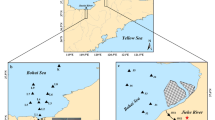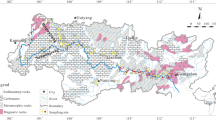Abstract
The grain size and element (including redox sensitive elements and terrigenous elements) concentration of surface sediments from the Changjiang Estuary hypoxia zone and its adjacent sea area were measured in this research. Based on the obtained data, the hypoxic environment’s influence on the distribution of elements in surface sediments was further studied. We believe that the “redox environment effect” greatly influences the distribution of the RSE, which reveals the “patchy enrichment pattern” offshore in the hypoxia zone, while the distribution of the terrigenous elements which shows the “stripped enrichment pattern” near shore is mainly affected by “granularity effects”. Due to the existence of the hypoxia zone of the Changjiang Estuary, the distribution of the RSE such as Mo, Cd and V in the study area exhibits the characteristics of “redox environment effects”.
Similar content being viewed by others
References
Adelson J M, Helz G R, Miller C V (2001). Reconstructing the rise of recent coastal anoxia; molybdenum in Chesapeake Bay sediments. Geochim Cosmochim Acta, 65: 237–252
Chaillou G, Anschutz P, Lavaux G, et al (2002). The distribution of Mo, U and Cd in relation to major redox species in muddy sediments of the Bay of Biscay. Mar Chem, 80: 41–59
Chen J Y, Chen X L, Yang Q L (1988). Investigation research on the resources of sea shore and beach of Shanghai. Shanghai: Shanghai Science and Technology Press (in Chinese with English abstract)
Chen S, Xu A Y, Luo B K (1987). The geochemistry of Fe, Mn, Zn, Co and Ni in surface sediments in Changjiang Estuary. Journal of Oceanography in Taiwan Strait, 6(1): 13–18 (in Chinese with English abstract)
Colodner D, Sachs J, Ravizza G, et al (1993). The geochemical cycle of rhenium: A reconnaissance. Earth and Planetary Science Letters, 117: 205–221
Crusius J, Calvert S, Pedersen T, et al (1996). Rhenium and molybdenum enrichments in sediments as indicators of oxic, suboxic and sulfidic conditions of deposition. Earth and Planetary Science Letters, 145: 65–78
Crusius J, Thomson J (2000). Comparative behavior of authigenic Re, U, and Mo during reoxidation and subsequent long-term burial in marine sediments. Geochemical et Cosmochimica Acta, 64(13): 2233–2242
Emerson S, Huested S S (1991). Ocean anoxia and the concentration of molybdenum in sea water. Mar Chem, 34: 177–196
Gao A G, Cai D L, Gao S L (2000). Geochemical characteristics of the elements in the sediment of the Yangtze Estuary. Proceeding of the Japan-China work ship on the cooperative study of the marine environment. In: Watanabe M, Zhu M Y, Eds. Research Report from the National Institute of Environmental Studies, Japan, 151: 151–158
Gu H K (1980). The maximum value of the vertical distribution for dissolved oxygen in Huanghai. Acta Oecanologica Sinica, 2: 70–79 (in Chinese with English abstract)
Koschinsky A (2001). Heavy metal distributions in Peru basin surface sediments in relation to historic, present and disturbed redox environments. Deep-Sea Research II, 48: 3757–3777
Li D J, Zhang J, Huang D J, et al (2002). Oxygen depletion off the Changjiang (Yangtze River) Estuary. Science in China (series D), 32: 686–694 (in Chinese)
Li Y X (1986). The neutron activation analysis and geochemistry research on sediment in East Sea Shelf. Acta Oecanologica Sinica, 8(2): 566–572 (in Chinese with English abstract)
Limeburner R, Beardsley R C, Zhao J (1983). Water Masses and Circulation in the East China Sea. Proceedings of International Symposium on Sedimentation on the continental shelf, with special reference to the East China sea. Beijing: China Ocean Press, 285–294
Morford J L, Emeson S (1999). The geochemistry of redox sensitive trace metals in sediments. Geochimica Cosmochimica Acta, 63: 1735–1750
Rosenthal Y, Lam P, Boyle E A, et al (1995). Authigenic cadmium enrichments in suboxic sediments: Precipitation and post depositional mobility. Earth and Planetary Science Letters, 132: 99–111
Tian R C, Hu F X, Martin J M (1993). Summer nutrient fronts in the Changjiang (Yangtze River) Estuary. Estuarine, Coastal and Shelf Science, 37: 27–41
Wang J T (1990). REE geochemistry of surface sediments in Huanghai. Geochemistry, 1: 44–53 (in Chinese with English abstract)
Wang X J (1982). Geochemistry of sedimentary REE of the East Sea Shelf. Geochemistry, 1: 56–65 (in Chinese with English abstract)
Wang Z F (1990). Primary research on the Geochemistry of Cu in Changjiang Estuary. Geochemistry, 1: 90–96 (in Chinese with English abstract)
Xu SM (2005). The Distribution and Environmental Significance of Redox Sensitive Elements in the Hypoxia Zone of the Changjiang Estuary and its Contiguous Area. Dissertation of Qingdai Ocean University of China (in Chinese with English abstract)
Xu S M, Zhai S K, Zhang A B, et al (2007). Distribution and environment significance of redox sensitive elements off the Changjiang Estuary hypoxia zone and its contiguous sea area. Sedimentology, 25(5): 759–766 (in Chinese with English abstract)
Yang Z S (1988). Clay mineral combination in sediment of the Huanghe, Changjiang and Zhujiang River, chemical characteristic and their relations with climate of reserous area. Oceanologia et Limnologia Sinica, 19(4): 336–346 (in Chinese with English abstract)
Ye Y G (1991). The geochemistry of 210Pb, Al, Fe, Mn and Cu of the core ZK226 in modern Huanghe delta. Marine Geology and Quaternary Geology, 11(4): 25–33 (in Chinese with English abstract)
Zhang J, Ying S L (1996). Granular heave metal in Changjiang Estuary. Bio-geochemistry research of primary estuary in China. Beijing: China Ocean Press, 146–159 (in Chinese with English abstract)
Zhang X D, Zhai S K, Xu S M, et al (2005). Study on the “granularity effect” on the redox sensitive elements of sediments off the Changjiang Estuary hypoxia zone and its contiguous sea area. Journal of Ocean University of China, 35(5): 868–874 (in Chinese with English abstract)
Zhao Y Y (1983). Several geochemistry modes in Chinese sea shelf. Geology Science, 4: 307–314 (in Chinese with English abstract)
Zhao Y Y, Yan M C (1992). The comparison of elements concentration in sediment in Huanghe, Changjiang and shallow sea in China. Chinese Sci Bull, 13: 1202–1204 (in Chinese)
Zhao Y Y, Yan M C (1994). The Geochemistry of Sediment in Shallow Sea of China. Beijing: Science Press (in Chinese)
Author information
Authors and Affiliations
Corresponding author
Additional information
__________
Translated from Marine Geology & Quaternary Geology, 2007, 27(3):1–8 [译自: 海洋地质与第四纪地质]
Rights and permissions
About this article
Cite this article
Xu, S., Zhai, S., Zhang, A. et al. Redox environment effect on redox sensitive elements in surface sediments of the Changjiang Estuary hypoxia zone. Front. Earth Sci. China 2, 10–16 (2008). https://doi.org/10.1007/s11707-008-0005-1
Published:
Issue Date:
DOI: https://doi.org/10.1007/s11707-008-0005-1




